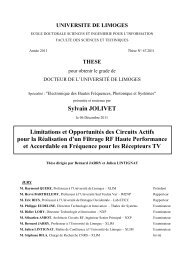Etude théorique de radars géologiques - Epublications - Université ...
Etude théorique de radars géologiques - Epublications - Université ...
Etude théorique de radars géologiques - Epublications - Université ...
Create successful ePaper yourself
Turn your PDF publications into a flip-book with our unique Google optimized e-Paper software.
Étu<strong>de</strong> <strong>théorique</strong> <strong>de</strong> <strong>radars</strong> <strong>géologiques</strong> : analyses <strong>de</strong> sols, d'antennes et<br />
interprétation <strong>de</strong>s signaux<br />
➢ Résumé :<br />
Les <strong>radars</strong> <strong>géologiques</strong> jouent un grand rôle pour la prospection non <strong>de</strong>structive dans <strong>de</strong>s domaines<br />
aussi variés que le génie civil ou la recherche spatiale : détection d'objets enfouis, recherche d'eau liqui<strong>de</strong><br />
dans le sol <strong>de</strong> Mars... Leur évolution nécessite étu<strong>de</strong>s <strong>théorique</strong>s et simulations rigoureuses afin <strong>de</strong> se<br />
focaliser sur les phénomènes physiques.<br />
La 1 ère partie <strong>de</strong> ce mémoire porte sur la génération <strong>de</strong> sols réalistes et sur le calcul du champ diffracté.<br />
La 2 ème partie rappelle le principe <strong>de</strong>s antennes large ban<strong>de</strong> et détaille le fonctionnement <strong>de</strong> l'antenne<br />
amortie selon le modèle <strong>de</strong> WuKing.<br />
La 3 ème partie relative à l'interprétation <strong>de</strong>s échos <strong>radars</strong> propose un modèle analytique déterminant le<br />
signal reçu lorsque le sol se compose d'une succession d'interfaces planes. Combiné à un algorithme<br />
génétique, ce modèle permet d'inverser <strong>de</strong>s résultats <strong>de</strong> simulations. Enfin, une méthodologie permettant<br />
l'obtention <strong>de</strong> Bscans est développée pour visualiser la signature d'objets.<br />
Mots clés : radar GPR, surface rugueuse, milieu hétérogène, fractal, rétrodiffusion, antenne large ban<strong>de</strong>,<br />
WuKing, FDTD, problème inverse, algorithme génétique, Bscan<br />
Theoretical studies of GPR : soils, antennas and signal interpretation<br />
analysis<br />
➢ Abstract :<br />
Ground Penetrating Radars (GPR) contribute in non<strong>de</strong>structive survey in various domains as<br />
engineering or spatial research : buried objects <strong>de</strong>tection, liquid water in the ground of Mars prospecting...<br />
Their evolution requires theoretical studies and rigorous simulations to focus on the physical phenomena.<br />
The 1 st part of this manuscript <strong>de</strong>als with realistic soils generation and scattered field estimation.<br />
The 2 nd part recalls the principle of wi<strong>de</strong> bandwidth antennas and <strong>de</strong>scribes the functioning of Wu<br />
King loa<strong>de</strong>d dipole.<br />
The 3 rd part related to echo interpretation proposes an analytical mo<strong>de</strong>l which <strong>de</strong>termine the received<br />
signal when the soil is composed of a succession of smooth interface. Coupled to genetic algorithm, this<br />
mo<strong>de</strong>l inverts simulated datas. Finally, a methodology allowing the drawing of Bscans is <strong>de</strong>veloped for the<br />
visualization of objet's response.<br />
Key words : GPR radar, rough surface, heterogeneous layer, fractal, backscattering, large bandwidth<br />
antennas, WuKing, FDTD, inverse problem, genetic algorithm, Bscan

















